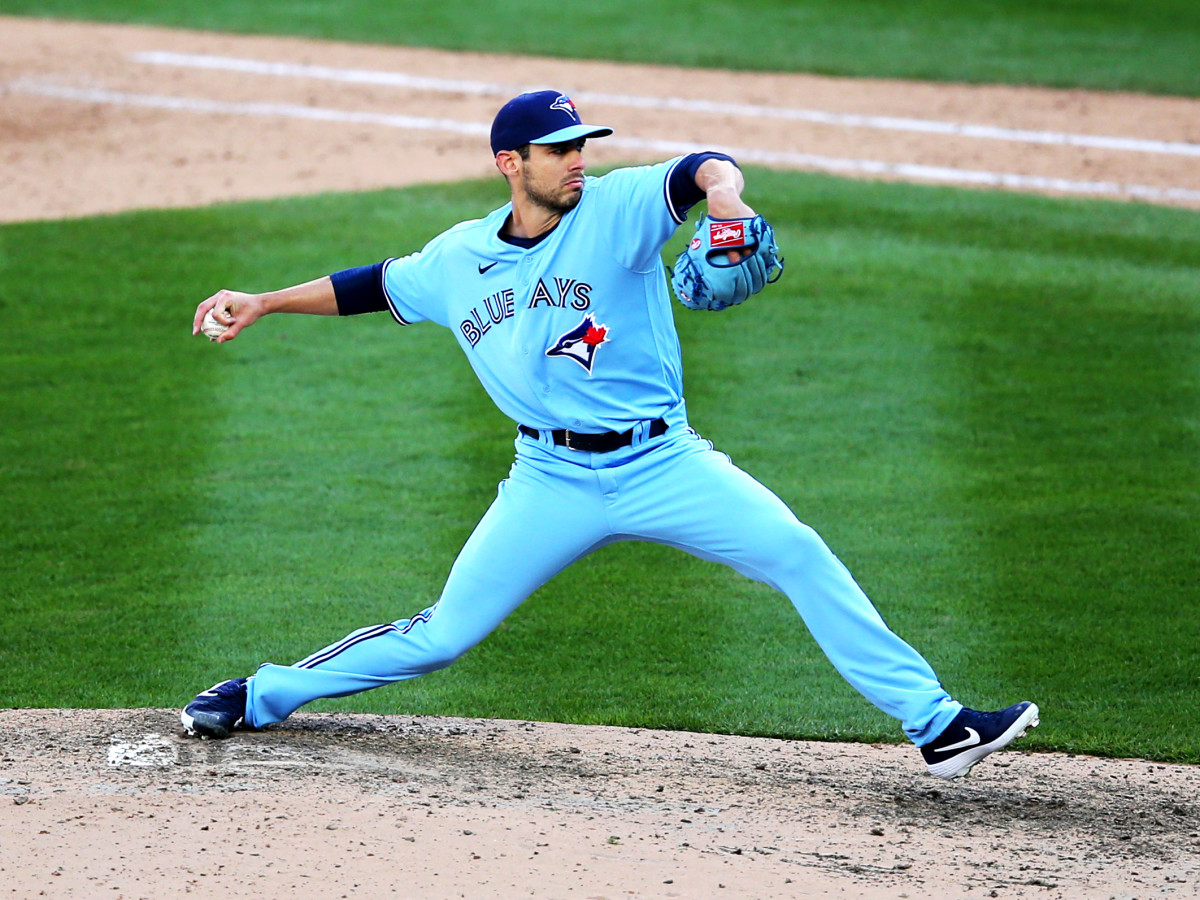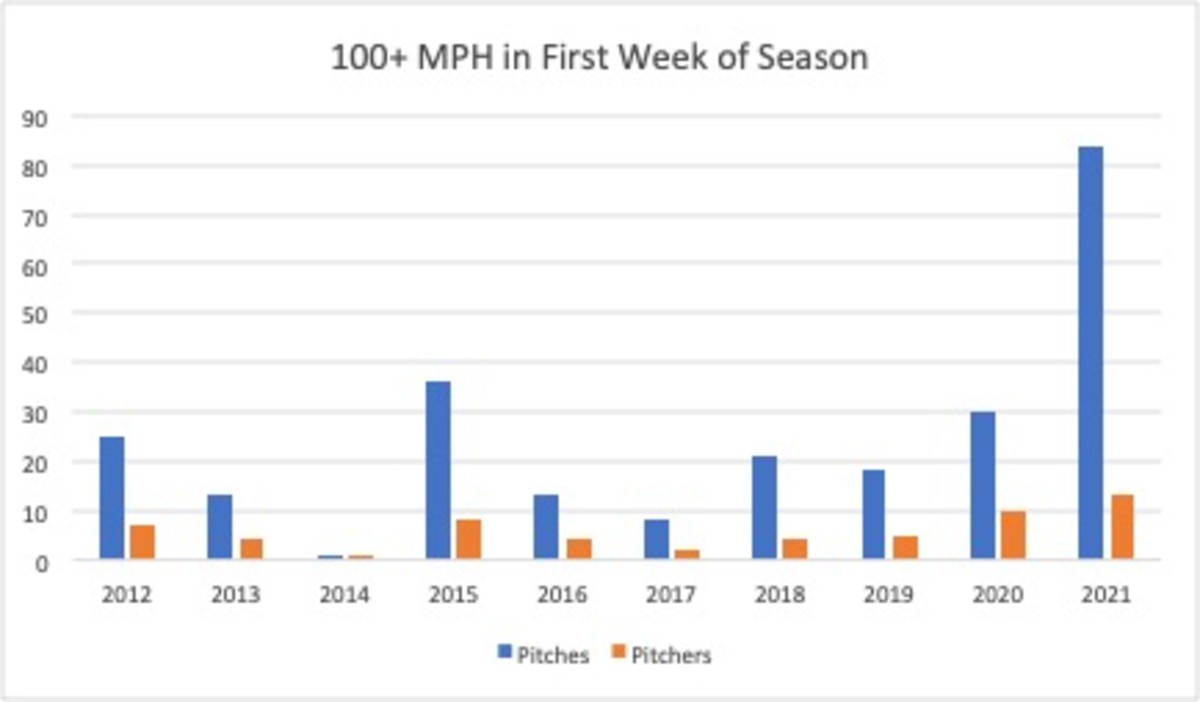Welcome to the Age of Learned Velocity

Welcome to The Opener, where every weekday morning you’ll get a fresh, topical column to start your day from one of SI.com’s MLB writers.
Toronto Blue Jays reliever Julian Merryweather is a pitching freak. Nobody in the recorded history of the past two decades can throw a fastball as hard as Merryweather and deaden a changeup as much. His average gap between those two pitches this year is an unprecedented 17.6 mph, with a maximum of 21.9 mph between his fastest fastball (100.4) and slowest changeup (78.5).
Merryweather has been almost impossible to hit. He has faced 14 batters this year and struck out half of them. He has allowed only one hit, a bloop single.
A 29-year-old rookie without fanfare, Merryweather would seem to be an anomalous success story. He and his then 86-mph fastball were un-recruited by Division I schools out of high school, he went 0–7 with a 6.67 ERA in his second season of junior college, pitched two years in NAIA college ball, received a bonus of just $20,000 as a senior fifth-round draft pick by Cleveland, threw in the low 90s, blew out his elbow and was traded while rehabbing from Tommy John surgery, but remained in Cleveland’s care for a month before joining Toronto.

But the breakout story of Julian Merryweather is the story of this generation of pitchers. It is the rule, not the anomaly. It is happening everywhere—in pitching labs, training centers, and amateur and professional bullpens. What was once thought to be a God-given gift—the blessing to throw hard—is now understood to be a skill that through modern technology, medicine and understanding of kinesiology can be enhanced.
A baseline of natural ability is required. Merryweather, for instance, is 6' 4" and 215 pounds. He has the long levers and athleticism that coaches look for in pitchers. Discipline and hard work are required, especially for pitchers such as Merryweather who return from Tommy John surgery.
But turning average throwers into elite throwers is being done as a matter of course, like teaching someone a new position, teaching a catcher how to frame pitches or teaching a student a second language. We have entered a world where throwing a pitch 100 miles an hour is an everyday occurrence, even from someone who was un-recruited and throwing in the mid-80s out of high school.
Back in 2010, fans in Cincinnati rushed to the bullpen just to watch Aroldis Chapman warm up for his debut, such was the wonder of someone who could throw 100 mph. In the opening week of the 2014 season, only one pitch was clocked at 100 mph, by Carlos Martínez of the Cardinals. Seven years and an explosion in research and development later, there were a record eighty-four 100-mph pitches thrown by a record 13 pitchers in the first week of this season. Look at the amazing jump in elite velocity we are seeing this year:

Perhaps the less lively baseball introduced this year is playing a role in the jump in velocity. The baseballs have a narrower range of allowable size and weight specifications. But the gains in training velocity have been going on for years.
“I hadn’t really thought about the ball as a factor,” said Brewers president of baseball operations David Stearns. “I think pitchers continue to get better at their training and part of that results in improved velo. I also think there may be some ‘fresh arm’ velo spikes showing up early in the season coming off reduced workloads last year.”
Stearns can see such spikes every night with his own team. Among Brewers pitchers showing increased four-seam velocity are Josh Hader (+3.0 mph), Brent Suter (+2.5), Freddy Peralta (+1.5), J.P. Feyereisen (+1.2) and Corbin Burnes (+1.0).
Overall, Milwaukee’s average four-seam velocity increased by 1.1 mph from last year. That is the fifth-largest such team spike behind Atlanta (+1.9), Washington (+1.8), Texas (+1.6), Miami (+1.4) and tied with the Angels (+1.1).
Other pitchers who are showing velocity jumps include Zack Wheeler (+0.8), Sandy Alcantara (+0.7), Tyler Glasnow (+0.7) and Jacob deGrom (+0.5).
But what do we find if we account for a rebound effect from the truncated season? What happens when we look at Statcast data from MLB four-seam fastballs only in the first week of each season?
Here is what we find: Pitchers have added a full mile per hour and 100 rpm to their four-seam fastballs in the six Statcast years. That is significant growth in a short period, with most of the jump found in the past two years.
MLB Four-Seam Fastball Metrics in Week 1
Year | MPH | Pct. | RPM | BA |
|---|---|---|---|---|
2021 | 93.5 | 34.9% | 2,321 | .250 |
2020 | 93.3 | 34.3% | 2,311 | .246 |
2019 | 92.9 | 35.2% | 2,288 | .252 |
2018 | 92.9 | 34.5% | 2,272 | .238 |
2017 | 92.9 | 33.4% | 2,278 | .248 |
2016 | 92.8 | 34.0% | 2,264 | .275 |
2015 | 92.5 | 32.1% | 2,231 | .253 |
This is the Age of Learned Velocity. And as pitchers take more time between pitches and teams give them shorter outings and more rest, pitchers max out on their velocity more often. The Tampa Bay Rays have deployed this kind of sports science as well as any team. If there is a downside to this “max velo” trend, it could be found in injury risk. Eight of Tampa Bay’s 11 most-used relief pitchers since 2019 have broken down, including Chaz Roe, Andrew Kittredge, Oliver Drake, Jalen Beeks, Colin Poche, Nick Anderson and Pete Fairbanks in the past 12 months.
Throwing harder is only part of the story when it comes to how technology and training have changed the game. Despite the increase in 100-mph throwers, pitchers continue to throw fewer fastballs than ever before.
Through Friday, the percentage of true fastballs (four-seamers, two-seamers and sinkers) is down for a fifth straight year—from 55.6% fastballs in 2016 to 50.1% in 2021. It seems counterintuitive that over the past five years, fastballs have become faster (+0.4 mph) with more spin (+51 rpm) and are harder to hit (-.024 batting average points) but are being used less. But that’s because technology and training are working their same magic on spin, and spin is harder to hit than velocity.
Take Joe Musgrove as an example. In throwing the first no-hitter in Padres history on Friday night, Musgrove threw only 15 fastballs among his 112 pitches. His 13.4% fastball usage was the lowest of his 110 career games. Overall this season, Musgrove is throwing his fastballs harder than ever in his six-year major league career (93.4 mph) and throwing them less than ever (19.5%).
Merryweather also is throwing his fastball harder (98.3 mph, up from 96.7 last year) but less often (54.7%, down from 57.1%). His changeup is that good—and that different from his fastball. Merryweather never has allowed a hit on the 51 changeups he has thrown in his young career. (He also throws a slider and curveball.)
It’s a great example of why measuring a pitch in sequence is more accurate than measuring it in isolation. How does it differ from the previous pitch in velocity and location? How does it resemble the previous pitch in pitch path?
There have been 321 pitchers who averaged 95 mph or greater with their fastball over the past 20 seasons, according to Fangraphs data. Not one of them created a bigger career velocity gap between fastball and changeup than Merryweather (min. 10% changeups)
Biggest Career Fastball-Changeup Velocity Gap (2002–21)
Name | MPH Diff. |
|---|---|
1. Julian Merryweather | 16.3 |
T2. Spencer Howard | 14.5 |
T2. Robert Stock | 14.5 |
T2. Brian Stokes | 14.5 |
T5. Dylan Cease | 14.0 |
T5. Erick Threets | 14.0 |
After graduating from Junipero Serra High School in San Mateo, Calif., Merryweather pitched two seasons at Skyline College, a junior college in San Bruno. He posted ERAs of 4.35 and 6.57 with a combined record of 4–13. He then attended Oklahoma Baptist, an NAIA power, where he blossomed into a star, going 22–5 with a 1.73 ERA.
Cleveland developed him as a starting pitcher. From 2014–17, Merryweather was 23–20 with a 3.91 ERA until 2018, when he blew out his elbow. He was throwing 91–94 at the time, occasionally hitting 97.
Merryweather underwent Tommy John surgery on March 9, 2018. Five months later at the August trade deadline, Cleveland wanted third baseman Josh Donaldson from Toronto for the stretch drive. Blue Jays president Mark Shapiro and general manager Ross Atkins had joined the Blue Jays after the 2015 season from Cleveland, where they had drafted Merryweather. For one month of Donaldson, they asked for a pitcher who could not pitch at the time.
The clubs agreed to the deal but because of roster rules announced it as Donaldson for a player to be named. Merryweather was told he had been traded but to keep it private until he was officially named as the player, which turned out to be on Oct. 5. For one month, Merryweather continued to rehab and train with Cleveland personnel even though he was a Blue Jay.
Merryweather took a long way back. Because of his rehab and the shutdown from the pandemic, in the 36 months after his surgery, he threw only 25 innings. But his velocity kept increasing. He pitched eight times for Toronto last year: three times as a starter and five times out of the bullpen. He arrived at spring training this season as a relative unknown without a clear role. But his elite fastball-changeup combination was too obvious to ignore.
On Opening Day, with closer Kirby Yates lost for their season, manager Charlie Montoyo asked Merryweather to protect a 3–2 ninth-inning lead against New York at Yankee Stadium. Merryweather struck out Aaron Hicks, Giancarlo Stanton and Gleyber Torres on 11 pitches. No pitcher last season saved a game by striking out the side on 11 pitches or fewer. (Corey Knebel would do so for the Dodgers on 10 pitches nine days later.)
Merryweather may be a breakout star of the early season, but he is just one of 15 pitchers who have hit 100 mph entering Sunday, including Mets reliever Miguel Castro, who in three years, increased his fastball velocity from 95.4 mph to 98.9 mph; Braves reliever Tyler Matzek, who was throwing in independent ball two years ago and added 2 mph just since last year; and Cleveland reliever Emmanuel Clase, who has thrown the most 100-mph pitches in MLB this year (29) after missing last season due to a PED suspension.
Seeing someone clock in at 100 mph is virtually an everyday occurrence. Only one day has gone by this season without somebody hitting triple digits. Pitchers are hitting 100 at the rate of almost one pitch per game (0.95)—that’s more than twice as often as last season (0.35) and 2019 (0.43).
There is a limit to just how fast a human can throw a baseball and the game is pushing up against it. Any faster and the shoulder would break apart. We won’t see someone throw 110 mph, for instance. But we will see more and more pitchers like Merryweather hitting triple digits and pushing up against the human limit.
